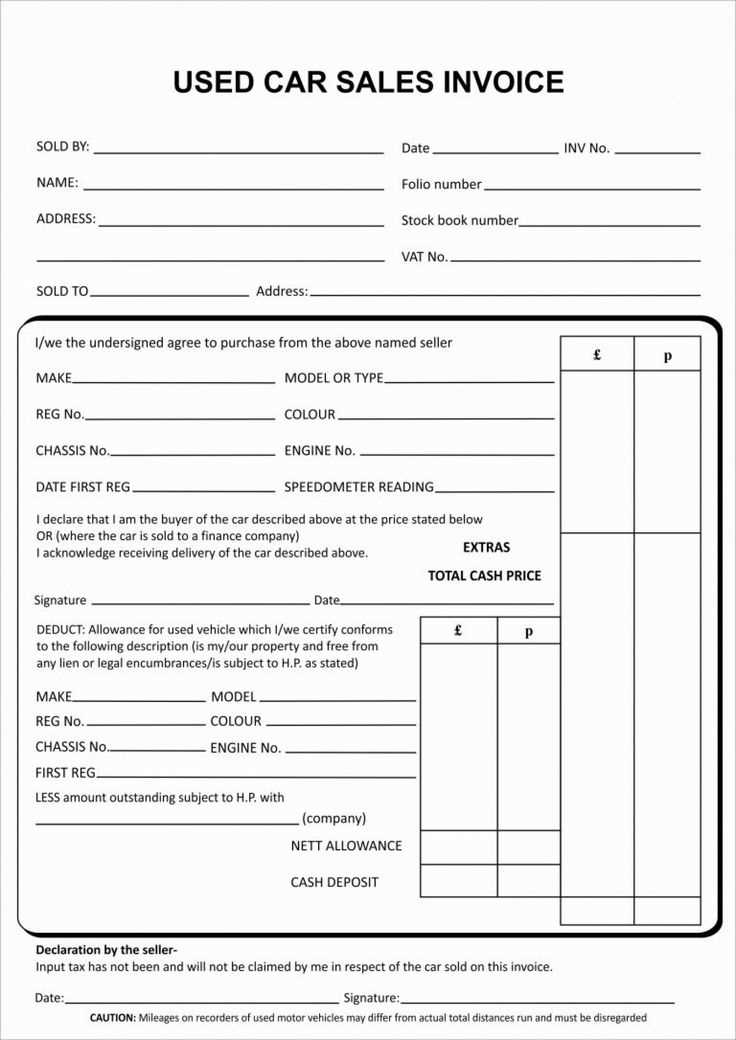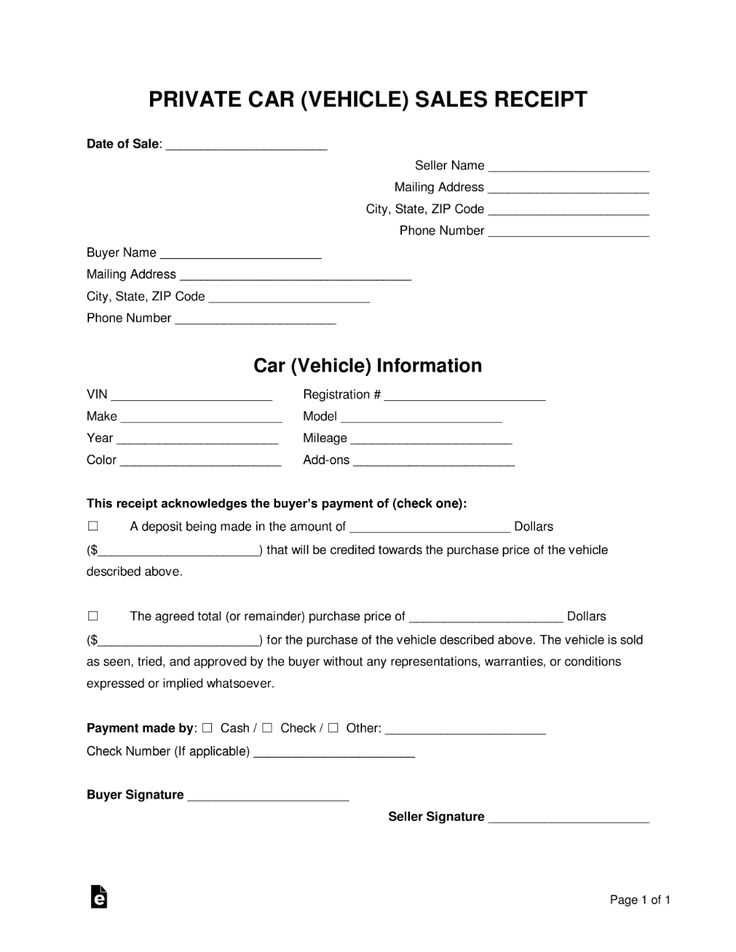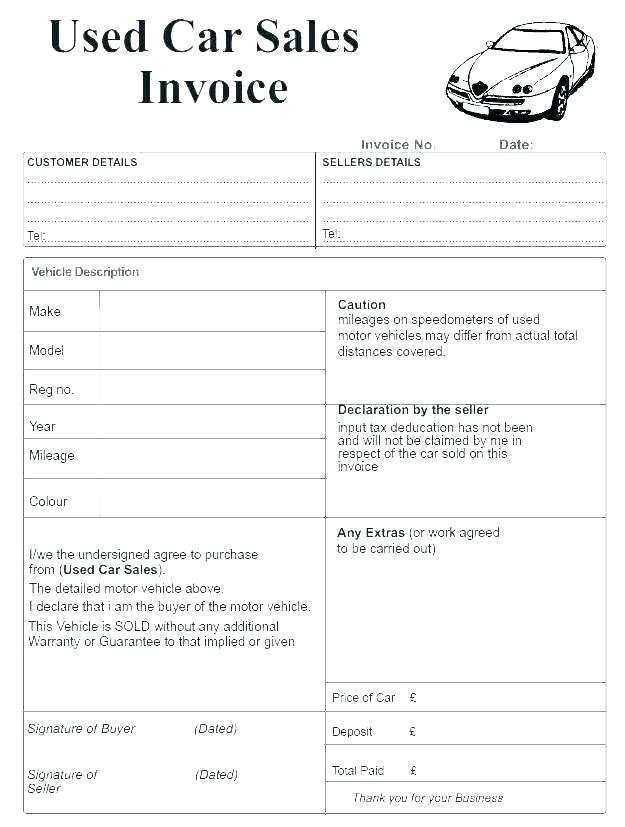
A well-structured receipt for used car sales provides clear documentation for both the buyer and seller. This simple document helps avoid future disputes and ensures both parties are on the same page about the transaction details.
Make sure to include the buyer’s and seller’s full names, addresses, and contact information. Identify the vehicle by make, model, year, and Vehicle Identification Number (VIN). Specify the sale price and any additional terms, like warranties or promises made by the seller.
It’s crucial to mention the condition of the vehicle at the time of sale, noting any damages or existing issues. This helps protect the seller from future claims regarding the car’s condition after the transaction.
Including the date of the transaction and signatures from both parties confirms the agreement and closes the deal. A receipt should also state whether the transaction was paid in full or through financing, as well as any deposits made. Consider using a standard template that covers all these details for a smoother, hassle-free sale process.
Here’s a revised version with reduced repetition:
When preparing a used car sales receipt, include the following details to ensure clarity and avoid confusion:
- Buyer and Seller Information: Clearly state both parties’ names, addresses, and contact details.
- Vehicle Description: List the make, model, year, VIN (Vehicle Identification Number), and odometer reading at the time of sale.
- Sale Terms: Specify the agreed-upon price and payment method. Mention if any down payments or financing arrangements are involved.
- Condition of the Vehicle: Include a clause confirming whether the car is sold “as-is” or with any warranties or guarantees.
- Signatures: Ensure both parties sign and date the receipt, confirming the terms of the sale.
Additional Considerations
- Registration and Title Transfer: Clarify that the buyer is responsible for completing the vehicle’s registration and title transfer.
- Disclosure of Known Issues: List any known defects or issues with the car that may affect its value or safety.
By incorporating these details, both parties will have a clear record of the transaction, reducing the risk of disputes later.
- Used Car Sales Receipt Template
To create a clear and straightforward used car sales receipt, include all key transaction details to avoid any confusion later. This will ensure both the buyer and seller are on the same page regarding the sale conditions.
Important Sections to Include

- Buyer’s and Seller’s Details: List full names, addresses, and contact information for both parties.
- Vehicle Information: Clearly state the car’s make, model, year, VIN, and current mileage.
- Sale Price: Indicate the agreed price and the payment method used (e.g., cash, bank transfer).
- Transaction Date: Ensure the exact date of the transaction is recorded.
- Condition of the Vehicle: Include a note on the car’s condition, such as “sold as-is” if applicable, or any warranties provided.
- Signatures: Both buyer and seller should sign and date the receipt to validate the sale.
Optional Additions
If there are any additional agreements or warranties, outline them clearly on the receipt. For example, if a down payment is involved or the buyer has agreed to return for repairs, specify those terms. Both parties should have a copy of the receipt for their records.
Ensure the vehicle information is correct to avoid future disputes. Include the make, model, year of manufacture, VIN (Vehicle Identification Number), mileage, and color of the car. Double-check the VIN, as this is the most critical identifier for the vehicle. The receipt should also state whether the car has a clean title or if there are any liens on it. If the car has been in an accident, provide details about the damage or repairs made.
The condition of the car is another important factor. Include both exterior and interior condition, noting any significant damage or wear. It’s also helpful to list the number of previous owners. If the vehicle is under any warranties, be sure to mention the type and remaining duration of the warranty.
| Field | Details |
|---|---|
| Make | For example, Toyota, Ford, etc. |
| Model | For example, Corolla, Focus, etc. |
| Year | Year of manufacture (e.g., 2015) |
| VIN | Unique 17-character code identifying the vehicle |
| Mileage | Current mileage on the vehicle (in miles or kilometers) |
| Color | Vehicle’s primary color |
| Title Status | Whether the car has a clean title or is salvaged |
| Accident History | Provide any accident-related information, if applicable |
| Warranty | Details of any remaining warranty |
Including this data in the sales receipt ensures transparency and protects both the seller and the buyer. Be thorough, and check the details before finalizing the receipt to prevent any errors.
Clearly outline the payment terms on the receipt. Specify the total amount paid, including the vehicle price, taxes, fees, and any additional charges. Include the payment method, whether cash, check, bank transfer, or financing, and ensure it is clear if a deposit has been made. If financing is involved, list the loan terms, such as the amount financed, interest rate, and payment schedule.
Payment Confirmation

Include a statement confirming that the payment has been received in full or the amount paid up to that point. This section can help prevent future disputes by providing clear evidence of payment progress.
Refund Policy
If applicable, note the conditions under which a refund can be requested. Specify the time frame and any required documentation for refund processing, which will help both parties manage expectations.
Ensure the sales receipt includes clear legal information regarding the transaction. Indicate the parties involved, the vehicle’s identification details, and the agreed price. Be precise about the sale conditions–whether it is “as-is” or includes any guarantees. If the vehicle comes with a warranty, specify the duration, coverage, and any exclusions. Mention the governing laws under which the contract is being executed and any local regulations that may apply.
Detail the seller’s obligations and the buyer’s rights. If the seller offers a warranty, provide specific terms, such as what repairs or replacements are covered and any necessary procedures for claims. Clarify if the warranty is transferable or limited to the original buyer. This information prevents misunderstandings and helps both parties understand their responsibilities.
Also, include any return policy information, if applicable. While most used cars are sold as-is, providing details about possible returns or exchanges can be helpful, especially if the seller offers a limited warranty. Always ensure these details comply with local consumer protection laws.
Ensure the receipt includes the complete car details such as the make, model, year, VIN (Vehicle Identification Number), and mileage. Clearly state the purchase price, any taxes, and additional fees. Both parties should sign and date the document. Include a statement regarding the condition of the vehicle and any warranties or disclaimers.
Important Information to Include

List the payment method (cash, check, or financing) and any down payment made. If there were any repairs or maintenance done before the sale, document those as well. Always provide contact information for both the buyer and seller for future reference.
Why Signatures Matter
Having signatures from both parties on the receipt confirms the transaction is finalized. It serves as proof of agreement and helps prevent disputes. Make sure the names are printed clearly next to the signatures for full transparency.


